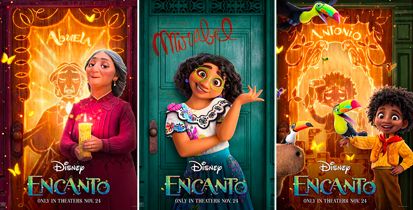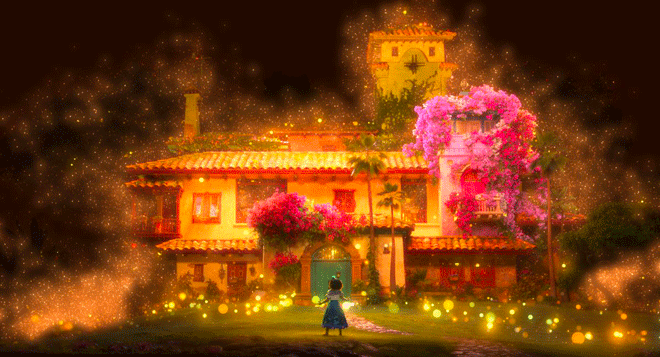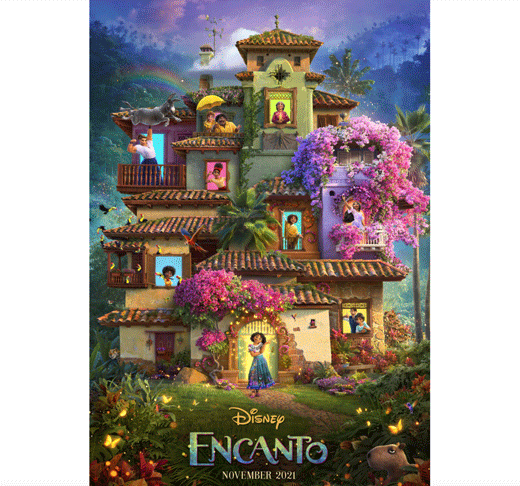Even amongst rapidly evolving technology, children’s films offer a kind of magic for both children and adults with its whimsy and nostalgia. In recent years, Disney’s fantasy films have moved away from European folklore, allowing the cultures and legends of people of colour to make it onto the screen. The 2021 film Encanto is part of this shift, enchanting its audience with the Latin literary tradition of magical realism.
Set in Columbia, Encanto tells the story of the multi-generational Madrigal family, and was directed by Jared Bush and Byron Howard with original songs by Lin Manuel Miranda. The film is a vibrant display of colour and culture, with a house that is conscious (fondly named “Casita”), a magical family that is multi-racial, and a magic that intertwines with the larger narrative.

Mirabel, the film’s protagonist, is young, awkward and the only ordinary girl born into the fantastical and magical family of the Madrigals. The magic begins with Abulo Pedro’s death, when Abuela, Abuelo and their new-born triplets flee their home along with the rest of their town. In Abuela’s agony, the magic erupts from the candle, the mountains rise to shield them from harm, and a house unfolds from the valley. The force that emanates from their home and candle grants supernatural powers to each child that is born into the house of Madrigal, from Abuela’s children to her grandchildren.
The Madrigals’ supernatural talents remain “a natural extension of these archetypes that we know very well, told in this tradition that’s tied to the country in which [the film is] set,” explains Bush. He continues, saying that it allowed the film’s creators “to use a type of magic that we’ve never done before — a magic born of emotion and personality and character. It was just really exciting to play in that realm.”

Unlike other notable forms of magic in Disney films, magical realism employs a kind of soft magic — one whose rules and backgrounds are unknown and unpredictable. In Encanto, as in magical realist novels, magic is an everyday occurrence. The Madrigal family live in the world with the rest of us; their magic is something that aids the community.
In a blend of fantasy and reality, magical realism commonly critiques society, particularly the elite and the political sphere. The rich storytelling tradition was popularised by Latin American writers in the 20th century, and spread to other countries that were similarly economically oppressed by the West. The film borrows a few elements, such as the intergenerational story and the butterfly motif, from Gabriel Garcia Marquez’s One Hundred Years of Solitude (1967), a defining magical realist book.
While the greater social and political themes are hinted at rather than explicitly emphasised as they are in magical-realist novels, Encanto holds true to the spirit of the genre. In familiarising the magic, Encanto renders the forced displacement of Abuela and Abuelo — something that still affects 3.5 million Colombian people — strange and unfamiliar.

Encanto captures the violence without a face — a violence that is more complex and intimate than a nemesis out for revenge. Abuelo Pedro’s death at the hands of armed forces leaves a lasting impact on the family, gifting them with their powers by sheer miracle and burdening them with fear.
At the heart of it, Encanto is a film about family. The magical gifts illuminate the familial relations in the Madrigal household. The film shows how intergenerational trauma is housed; the house itself crumbles under the family’s collective suffering. In an article discussing Encanto’s villain-free formula, writer Petrana Radulovic asks, “[w]hat does it mean for characters to rectify the mistakes of past generations, or confront their own weaknesses and prejudices?”
Through all its magical properties, Encanto exposes deeper truths about the things we deem familiar.
The truth of all this fantasy perhaps lies in Mirabel, the realism to the magic. She, as the figure who carries the narrative, seeks empathy and wonderment from her audience by allowing them to see the impossible as possible. Encanto honours the traditions of its literary heritage in ways understood by children from all backgrounds, and, through this, extends itself in support of the United Nations Sustainable Development Goals of Reduced Inequalities.
Amongst indigenous Colombian lore and fantastical adventures, the film also brings a story that is deeply human with or without any supernatural ability. The magic in Encanto lives in service of both the film and its viewers — representing those neglected by the film industry and showcasing their potential. The magic lives on, and we are able to live amongst it.
Encanto is available on Disney+ for streaming.
